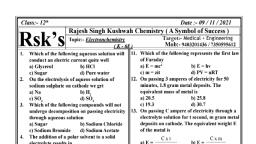Question 1 :
When the electric current is passed through a cell having an electrolyte, the positive ions move towards cathode and negative ions towards the anode. If the cathode is pulled out of the solution then____________.
Question 2 :
<span class="wysiwyg-font-size-small"><span class="wysiwyg-font-size-small"><p class="wysiwyg-text-align-left">Lithium is generally used as an electrode in high energy density batteries. This is because:</p>
Question 3 :
<span class="wysiwyg-font-size-small"><span class="wysiwyg-font-size-small"><p class="wysiwyg-text-align-left">Which of the following statements is true for fuel cells ?</p>
Question 5 :
<span class="wysiwyg-font-size-small"><span class="wysiwyg-font-size-small"><p class="wysiwyg-text-align-left">In which reactants are not contained within the cell but are continuously supplied from external source?</p>
Question 6 :
<span class="wysiwyg-font-size-small"><span class="wysiwyg-font-size-small"><p class="wysiwyg-text-align-left">In a galvanic cell, the reactions taking place in the anodic half cell and the cathodic half cell will be:</p>
Question 7 :
In a cell, the following reaction takes place: $Fe + CuSO_{4} \rightarrow FeSO_{4} + Cu$. The cell can be represented as:
Question 10 :
KCl can be used in salt bridge as electrolyte in which of the following cells?
Question 11 :
Assertion: Dry cell is a primary cell and lead storage cell is a secondary cell.<br/>Reason: A primary cell can only be used once while secondary cells are rechargeable.<br/>
Question 13 :
<span class="wysiwyg-font-size-small"><span class="wysiwyg-font-size-small"><p class="wysiwyg-text-align-left">Following are some of the facts about dry cell</p><p class="wysiwyg-text-align-left">i) It is also called Leclanche cell</p><p class="wysiwyg-text-align-left">ii) It is also called Daniel cell</p><p class="wysiwyg-text-align-left"><span class="wysiwyg-font-size-small"><span class="wysiwyg-font-size-small">iii) Electrolyte is a moist paste of NH$_{4}$Cl<span class="wysiwyg-font-size-small"><span class="wysiwyg-font-size-small">and ZnCl$_{2}$<span class="wysiwyg-font-size-small"><span class="wysiwyg-font-size-small">in starch</p><p class="wysiwyg-text-align-left">iv) Cathodic reaction is</p><p class="wysiwyg-text-align-left"><span class="wysiwyg-font-size-small"><span class="wysiwyg-font-size-small">MnO<span class="wysiwyg-font-size-small"><span class="wysiwyg-font-size-small">$_{2}$<span class="wysiwyg-font-size-xx-small"><span class="wysiwyg-font-size-xx-small"> <span class="wysiwyg-font-size-small"><span class="wysiwyg-font-size-small">(s) + NH$_{4}^{+}$<span class="wysiwyg-font-size-small"><span class="wysiwyg-font-size-small"> + e$^{-}\rightarrow $<span class="wysiwyg-font-size-small"><span class="wysiwyg-font-size-small">MnO(OH)+NH$_{3}$</p><span class="wysiwyg-font-size-small"><span class="wysiwyg-font-size-small"><p>Select correct facts :</p>
Question 14 :
<span class="wysiwyg-font-size-small"><span class="wysiwyg-font-size-small"><p class="wysiwyg-text-align-left">Which of the following reaction is used to make a fuel cell ?</p>
Question 15 :
<span class="wysiwyg-font-size-small"><span class="wysiwyg-font-size-small"><p class="wysiwyg-text-align-left">Which of the following energy changes occur in galvanic cell?</p>
Question 17 :
<span class="wysiwyg-font-size-small"><span class="wysiwyg-font-size-small"><p class="wysiwyg-text-align-left">The potential across the metal and the aqueous solution of its ions of unit activity at 298K is known as:</p>
Question 19 :
<span class="wysiwyg-font-size-small"><span class="wysiwyg-font-size-small"><p class="wysiwyg-text-align-left">Which one of the following cells can convert chemical energy of $O_{2}$ and $H_{2}$ directly into electrical energy:</p>
Question 22 :
<span class="wysiwyg-font-size-small"><span class="wysiwyg-font-size-small"><p class="wysiwyg-text-align-left">Hydrogen -Oxygen fuel cells are used in space craft to supply:</p>
Question 23 :
Which of the following is always true regarding the spontaneity of reaction occuring in a galvanic cell?
Question 24 :
In a fuel cell ${H}_{2}$ and ${O}_{2}$ react to produce electricity. In the process ${H}_{2}$ gas is oxidized at anode and ${O}_{2}$ at cathode. If 67.2 litre of ${H}_{2}$ at STP reacts in  15 minutes. The average current produced is:<br/>
Question 25 :
Which of the following statements about the spontaneous reaction occurring in a galvanic cell is always true?
Question 27 :
<span class="wysiwyg-font-size-small"><span class="wysiwyg-font-size-small"><p class="wysiwyg-text-align-left">List A                                List B</p> <p class="wysiwyg-text-align-left">A. Dry Cell                     (P) Primary cell</p> <p class="wysiwyg-text-align-left">B. Lead storage </p> <p class="wysiwyg-text-align-left"><span class="wysiwyg-font-size-small"><span class="wysiwyg-font-size-small">battery                             (Q) 38%$H_{2}SO_{4}$</p><i> </i><span class="wysiwyg-font-size-small"><span class="wysiwyg-font-size-small"><p class="wysiwyg-text-align-left"><span class="wysiwyg-font-size-small"><span class="wysiwyg-font-size-small">C. Ni-Cd cell                    (R) $MnO_{2}+C$</p><i> </i><span class="wysiwyg-font-size-small"><span class="wysiwyg-font-size-small"><p><span class="wysiwyg-font-size-small"><span class="wysiwyg-font-size-small">D.<i> </i>$H_{2}-O_{2}$ <span class="wysiwyg-font-size-small"><span class="wysiwyg-font-size-small">fuel cell         (S) Secondary cell</p>
Question 28 :
<span class="wysiwyg-font-size-small"><span class="wysiwyg-font-size-small"><p class="wysiwyg-text-align-left">What is the approximate quantity of electricity(in coulombs) required to deposit all the silver from 250 ml of 1 M AgNO$_{3}$ aqueous solution? <br/></p>
Question 32 :
Which of the following statements are correct about voltaic cell?<br>(I) Chemical energy isconverted into electrical energy.<br>(II) Electrons flow from anode to cathode.<br>(III) Oxidation occurs at anode.<br>(IV) Anode is negative and cathode is positive.
Question 33 :
For cell reaction : $Zn+ Cu^{2+} \rightarrow Zn^2 + Cu$ cell representation is:
Question 34 :
The weights of various ions liberated by passing the same current through different electrolytes are in the ratio of their:
Question 35 :
Which one is correct about a hypothetical electrochemical cell shown below?<br/>$\underset{A}{\ominus } | A^+ (XM) || B^+ (YM) | \underset{B}{\oplus}           E_{cell}  = + 0.20 V$<br/>
Question 36 :
Following are some of the facts about a dry cell<br/>I : It is also called Leclanche cell<br/>II : It is also called Daniel cell<br/>III : Electrolyte is a moist paste of 4 $NH_4Cl$ and 2 $ZnCl_2$ in starch<br/>IV : Cathodic reaction is<br/><span class="wysiwyg-font-size-small"><span class="wysiwyg-font-size-small">$2MnO_{2}(s)+2NH_{4}^{+}(aq)+2e^{-}\rightarrow Mn_{2}O_{3}(s)+2NH_{3}(g)+H_{2}O(l)$<br/>Select the correct facts.
Question 37 :
Which of the following reactions is correct for a given electrochemical cell at ${ 25 }^{ o }C$?<br/>$Pt\left| { Br }_{ 2 }\left( g \right)  \right| { Br }^{ - }\left( aq \right) ||{ Cl }^{ - }\left( aq \right) \left| { Cl }_{ 2 }\left( g \right)  \right| Pt$
Question 38 :
Assertion: The Daniell cell becomes dead after some time.
Reason: Oxidation potential of zinc anode decreases and that of copper increases.
Question 39 :
<span class="wysiwyg-font-size-small"><span class="wysiwyg-font-size-small"><p class="wysiwyg-text-align-left">In an electro chemical process, a salt bridge is used</p><p class="wysiwyg-text-align-left">a) to maintain electro neutrality in each solution.</p><p class="wysiwyg-text-align-left">b) to complete the circuit so that current can flow</p><p>c) as an oxidising agent</p><p>d) as a colour indicator</p>
Question 40 :
Read the passage given below and answer the question:<br/>Chemical reactions involve the interactions of atoms and molecules. A large number of atoms/molecules (approximately $6.023 \times 10^{23}$) are present in few grams of any chemical compound varying with their atomic/molecular masses. To handle such large numbers conveniently, the mole concept was introduced. This concept has implications in diverse areas such as analytical chemistry,  biochemistry, electrochemistry, and radiochemistry. the following example illustrates a typical case, involving chemical/electrochemical reaction, which requires a clear understanding of the mole concept.<br/>A 4.0 molar aqueous solution of NaCl is prepared and 500 mL of this solution is electrolyzed. This leads to the evolution of chlorine gas at one of the electrodes (atomic mass: Na = 23, Hg = 200; 1 faraday =96500 coulombs). <br/>The total charge (coulombs) required for complete electrolysis is:
Question 41 :
The potential of a hydrogen electrode in a solution with pH = 5 at $25^{\circ}C$ is:
Question 42 :
Assertion: In a galvanic cell, the half-cell with higher reduction potential provides a reducing agent.Reason: Easily reducible substances are good oxidants.<br/>
Question 44 :
Electrolysis of a dilute solution of aqueous sodium chloride results in the cathode product:
Question 45 :
Calculate the EMF of a Daniel cell when the concentration of $ZnSO_{4}$ and $CuSO_{4}$ are $0.001$ M and $0.1$ M respectively. The standard potential of the cell is $1.1$ V.<br/>
Question 46 :
Saturated solution of $KNO_{3}$ is used to make salt bridge because:
Question 47 :
<span class="wysiwyg-font-size-small"><span class="wysiwyg-font-size-small"><p class="wysiwyg-text-align-left">The chemical used in salt bridge in a galvanic cell is:</p>
Question 49 :
An electrolytic cell is constructed for preparing hydrogen. For an average current of 1 ampere in the circuit, the time required to produced $450mL$ of hydrogen at NTP is approximately.
Question 52 :
<p>In an experiment set up for the measurement of EMF of a half cell using a reference electrode and a salt bridge, when the salt bridge is removed, the voltage:</p>
Question 53 :
Foe the electrochemical cell:<br/>$Zn\left( s \right) |{ Zn }^{ 2+ }\left( aq \right) \parallel { Cl }^{ - }\left( aq \right) |{ Cl }_{ 2 }\left( g \right) |Pt\left( s \right) $<br/>Given : ${ E }_{ { Zn }^{ 2+ }/Zn }^{ o }=-0.76\ Volt$<br/>             ${ E }_{ { Cl }^{ - }/{ Cl }_{ 2 }\left( g \right)  }^{ o }=-1.36\ Volt$<br/>From these data one can deduce that:
Question 54 :
<span class="wysiwyg-font-size-small"><span class="wysiwyg-font-size-small"><p class="wysiwyg-text-align-left">The electrochemical cell stops working after some time because:</p>
Question 55 :
Splitting up of the water molecule by an electric current is an example of electrolysis.<br/>
Question 57 :
Which of the following will increase the voltage of the cell? <br/><br/>$Sn(s) + 2 \text{Ag}^+ (aq) \rightarrow 2Ag(s) + Sn^{2+}$
Question 58 :
The value of equilibrium constant for a feasible cell reaction is:
Question 59 :
<span class="wysiwyg-font-size-small"><span class="wysiwyg-font-size-small"><p class="wysiwyg-text-align-left">Some of the batteries are rechargeable :</p><p class="wysiwyg-text-align-left">I : Dry cell battery</p><p class="wysiwyg-text-align-left">II : Lead-storage (acid) battery</p><p class="wysiwyg-text-align-left">III : Nickel-cadmium battery</p><p class="wysiwyg-text-align-left">IV : Lithium battery</p><p class="wysiwyg-text-align-left">V : Fuel cell</p><p>Select correct alternates :</p>
Question 60 :
During the electrolysis of the aqueous solution of copper sulphate using Pt electrodes, the reaction taking place at anode electrode is:
Question 61 :
<span class="wysiwyg-font-size-small"><span class="wysiwyg-font-size-small"><p class="wysiwyg-text-align-left">In a galvanic cell, the positive ions of salt bridge migrate towards:</p>
Question 62 :
Which of the following statement (s) differentiate between electrochemical cell and electrolytic cell?
Question 63 :
Which of the following statements is true forthe electrochemical Daniel cell?
Question 64 :
<span class="wysiwyg-font-size-small"><span class="wysiwyg-font-size-small"><span class="wysiwyg-font-size-small"><p class="wysiwyg-text-align-left">For the galvanic cell :</p>$Al{(s)}|Al{^{3+}}{(aq)}(0.1M)|Ag{^{+}}{(aq)}(0.1M)|Ag{(s)},$<span class="wysiwyg-font-size-small"><span class="wysiwyg-font-size-small"><p>which of the following is/are correct?</p>
Question 66 :
State True or False.<br/>The effect of a change in the concentration of a reactant or product on the cell voltage can be predicted by applying Le-chateliers principle.
Question 67 :
Two platinum electrodes were immersed in a solution of $CuSO_4$ and electric current was passed through the solution. After some time, it was found that colour of $CuSO_4$ disappeared with evolution of gas at the electrode. The colorless solution contains:<br/>
Question 68 :
Which of the following reactions is used to make a fuel cell?
Question 70 :
In producing chlorine through electrolysis $100$ watt power at 125 V is being consumed. How much chlorine per minute is liberated ? Electrochemical Equivalent of chlorine is $0.367$ $\times$ 10$^{-6}$ kg/coulomb:
Question 71 :
<span class="wysiwyg-font-size-small"><span class="wysiwyg-font-size-small"><p class="wysiwyg-text-align-left">A lead storage battery containing 5.0 L of (1N) $H_{2}SO_{4}$ solution is operated for $9.65\times 10^{5}$ s with a steady current of 100 mA. Assuming volume of the solution remaining constant, normality of $H_{2}SO_{4}$ will:<span class="wysiwyg-font-size-small"><span class="wysiwyg-font-size-small"> </p>
Question 72 :
At $25^oC$, the standard oxidation potential of $Zn$ and $Ag$ in water are:<br/> $Zn(s)\rightarrow Zn^{+2}(aq)+2e^{-},\: E^{0}=0.76V$ <br/>and $Ag(s)\rightarrow Ag^{+}(aq)+e^{-},\: E^{0}=-0.80V$. <br/>Which of the following reaction actually takes place?












































